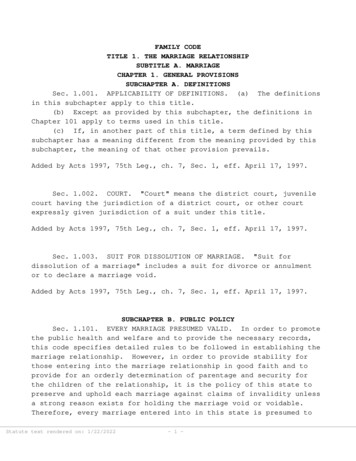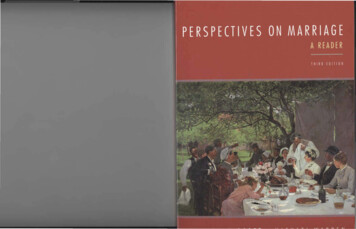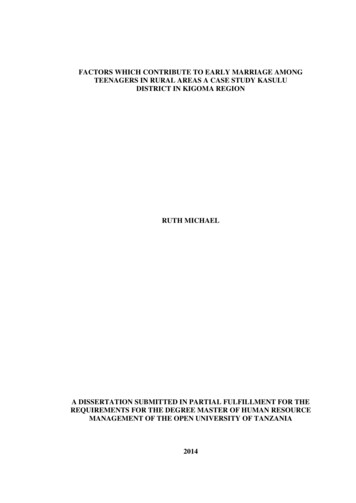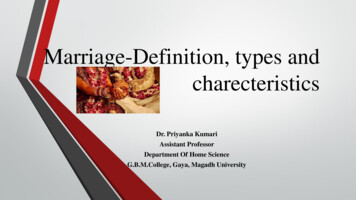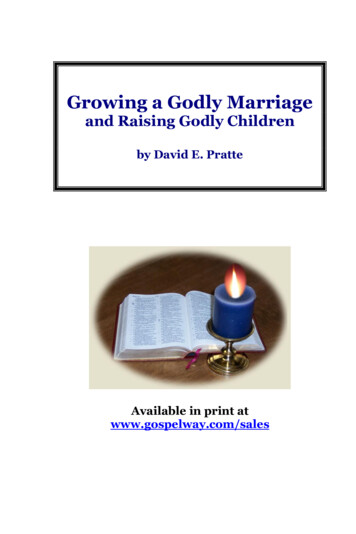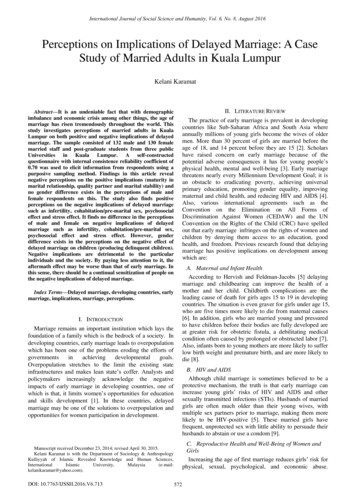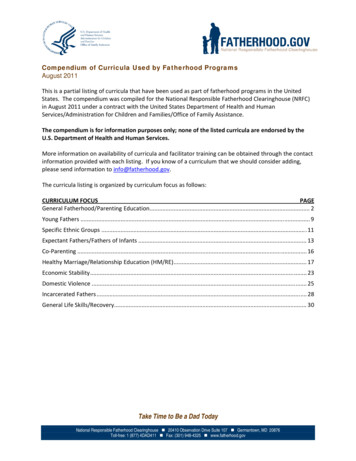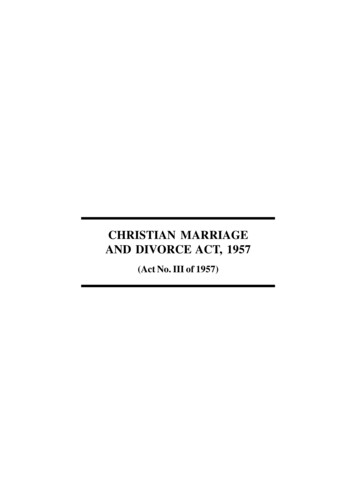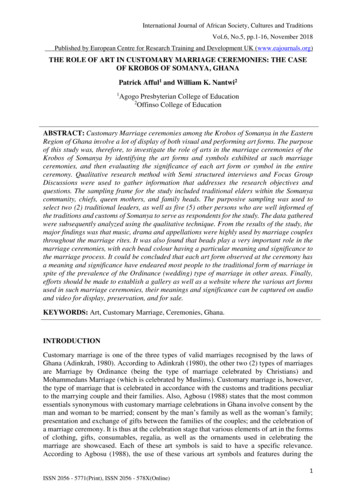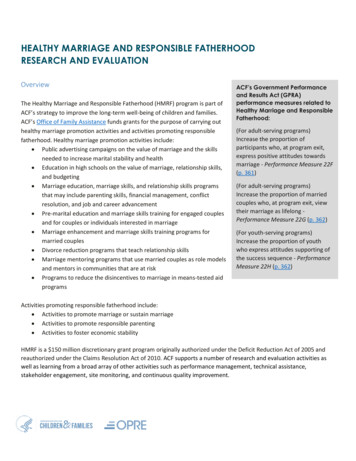
Transcription
HEALTHY MARRIAGE AND RESPONSIBLE FATHERHOODRESEARCH AND EVALUATIONOverviewThe Healthy Marriage and Responsible Fatherhood (HMRF) program is part ofACF’s strategy to improve the long-term well-being of children and families.ACF’s Office of Family Assistance funds grants for the purpose of carrying outhealthy marriage promotion activities and activities promoting responsiblefatherhood. Healthy marriage promotion activities include: Public advertising campaigns on the value of marriage and the skillsneeded to increase marital stability and health Education in high schools on the value of marriage, relationship skills,and budgeting Marriage education, marriage skills, and relationship skills programsthat may include parenting skills, financial management, conflictresolution, and job and career advancement Pre-marital education and marriage skills training for engaged couplesand for couples or individuals interested in marriage Marriage enhancement and marriage skills training programs formarried couples Divorce reduction programs that teach relationship skills Marriage mentoring programs that use married couples as role modelsand mentors in communities that are at risk Programs to reduce the disincentives to marriage in means-tested aidprogramsACF’s Government Performanceand Results Act (GPRA)performance measures related toHealthy Marriage and ResponsibleFatherhood:(For adult-serving programs)Increase the proportion ofparticipants who, at program exit,express positive attitudes towardsmarriage - Performance Measure 22F(p. 361)(For adult-serving programs)Increase the proportion of marriedcouples who, at program exit, viewtheir marriage as lifelong Performance Measure 22G (p. 362)(For youth-serving programs)Increase the proportion of youthwho express attitudes supporting ofthe success sequence - PerformanceMeasure 22H (p. 362)Activities promoting responsible fatherhood include: Activities to promote marriage or sustain marriage Activities to promote responsible parenting Activities to foster economic stabilityHMRF is a 150 million discretionary grant program originally authorized under the Deficit Reduction Act of 2005 andreauthorized under the Claims Resolution Act of 2010. ACF supports a number of research and evaluation activities aswell as learning from a broad array of other activities such as performance management, technical assistance,stakeholder engagement, site monitoring, and continuous quality improvement.
Past Research and EvaluationHealthy Marriage and Relationship Education (HMRE)A large body of research has shown that, on average, children raised in stable, two-parent families have better outcomeson a range of measures, even into adulthood.25,26,27,28 Research has also identified dimensions of couples’ relationshipfunctioning (e.g., positive communication, effective conflict management, problem solving, etc.) that could be modifiedor enhanced through relationship- focused educational programming.29 Some evaluations have found that suchprogramming can produce improvement in multiple dimensions of relationship quality and reductions in break-up ordivorce.30,31 While early research focused primarily on middle-class, white couples who were engaged or married32, ACFhas supported research on healthy marriage and relationship education for more diverse populations. Past ACF researchincludes the completion of three large scale randomized controlled trials of healthy marriage and relationship educationprograms (the Supporting Healthy Marriages, Building Strong Families, and Parents and Children Together evaluations)and one quasi-experimental trial of healthy marriage community initiatives (the Community Healthy MarriagesInitiatives evaluation).Responsible Fatherhood (RF)In recent decades, efforts to support and promote responsible fatherhood have been spurred by research that shows alink between supportive fathering and positive child outcomes.33,34,35 Responsible fatherhood programs aim to provideresources and supports to fathers around healthy marriage and relationships, parenting, and economic stability. Muchof the early research in the area of fatherhood had focused on fathers with middle-income or who were divorced. The25Waldfogel, J., Craigie, T., & Brooks-Gunn, J. (2010). Fragile Families and Child Wellbeing. Future Child, 20(2), .pdf26Lee, D., & McLanahan, S. (2015). Family structure transitions and child development: instability, selection, and population heterogeneity.American Sociological Review, 80(4), 738-763. https://doi.org/10.1177%2F000312241559212927Wu, L., & Martinson, B. (1993). Family structure and the risk of premarital birth. American Sociological Review, 58(2), n, A., Flay B. R., Embry, D. D., & Sandler, I. N. (2012). The Critical Role of Nurturing Environments for Promoting Human Well-Being.American Psychologist, 67(4), 257–271. https://doi.org/10.1037/a002679629Blanchard, V. L., et al. (2009). Investigating the Effects of Marriage and Relationship Education on Couples’ Communication Skills: A MetaAnalytic Study. Journal of Family Psychology 23(2), 203–214. http://dx.doi.org/10.1037/a001521130Hawkins, A. J., et al. (2008). Does Marriage and Relationship Education Work? A Meta-Analytic Study. Journal of Consulting and ClinicalPsychology, 76(5), 723–734. f31Moore, Q., Avellar, S., Patnaik, A., Covington, R., & Wu, A. (2018). Parents and Children Together: Effects of Two Healthy Marriage Programs forLow-Income Couples (OPRE Report #2018-58). Washington, DC: Office of Planning, Research, and Evaluation, Administration for Children andFamilies, U.S. Department of Health and Human Services. rograms-for-low-income-couples32Johnson, M. D. (2012). Healthy marriage initiatives: On the need for empiricism in policy implementation. American Psychologist, 67(4), 4333Adamsons, K. & Johnson, S. K. (2013). An Updated and Expanded Meta-Analysis of Nonresident Fathering and Child Well-Being. Journal of FamilyPsychology, 27(4), 589–599. era, N.J., Shannon, J. D., & Tamis-LeMonda, C. (2007). Fathers’ Influence on their Children’s Cognitive and Emotional Development: FromToddlers to Pre-K. Applied Developmental Science, 11, 208–213. https://doi.org/10.1080/1088869070176210035Yoder, J.R., Brisson, D., & Lopez, A. (2016). Moving Beyond Fatherhood Involvement: The Association Between Father–Child Relationship Qualityand Youth Delinquency Trajectories. Family Relations, 65(3), 462–476. https://doi.org/10.1111/fare.12197
field of research on responsible fatherhood with men with low incomes or who have never married is growing. Thoughthe field can draw from some of the past research, the unique circumstances of men with low-income, particularlyfathers who do not reside with their children, necessitate a distinct line of inquiry. ACF has completed one large scalerandomized controlled trial of responsible fatherhood programs as part of the Parents and Children Together evaluation.Research and Evaluation StakeholdersIn setting HMRF research and evaluation priorities, ACF takes into account legislative requirements and Congressionalinterests; the interest and needs of ACF, HHS, and Administration leadership; program office staff and leadership; ACFpartners; the populations served; researchers; and other stakeholders. ACF routinely interacts with these stakeholdersthrough a variety of engagement activities. These activities inform our ongoing research and evaluation planningprocesses.Who State, territory, tribal, local, and non-profit HMRF administrators and staffHMRF training and technical assistance providersHMRF curriculum or model developersPopulations served by HMRF programs, including adult couples, adult individuals, youth of high schoolage, fathers involved in the justice system, and fathers in communitiesFederal partners in HHS and other agencies, such as the Office of the Assistant Secretary for Planningand Evaluation (ASPE), the Centers for Disease Control (CDC), the National Institutes of Justice at theDepartment of Justice (DOJ/NIJ), and the Department of Labor (DOL)Researchers and policy expertsNational organizations, resource centers, and clearinghouses, such as the National Resource Center forHealthy Marriages and Families and the National Responsible Fatherhood ClearinghousePartners in the fields of child welfare, child support and enforcement, domestic violence prevention andintervention, and the criminal justice systemHow Conferences and meetings, such as the National Fatherhood Summit and other national conferencesthat include an emphasis on HMRF programs, such as the Research and Evaluation Conference on SelfSufficiency (RECS)HMRF Grantee ConferenceEngagement with HMRF training and technical assistance networksSurveys, focus groups, interviews, and other activities conducted as part of research and evaluationstudiesStructured mechanisms for broad stakeholder engagement, such as the Fatherhood, Relationships, andMarriage – Illuminating the Next Generation (FRAMING) Research Project, which is working tounderstand how stakeholders make use of existing research, and is identifying gaps in the knowledgebase related to HMRF programs
Examples of Broad Questions1. Who do HMRF programs serve and how are HMRF programs implemented?2. How can HMRF programs use data and evidence to strengthen their program implementation in order toimprove outcomes?3. How can HMRF programs better serve specific sub-populations, including:a. Youth and young adultsb. Non-resident fathersc. Fathers involved with the justice systemd. Adults participating in healthy marriage programs as individualse. Adults and youth experiencing intimate partner violence (IPV) or teen dating violence?f. Families in rural contexts4. How do HMRF programs affect marriage/relationship, parenting, and economic stability outcomes for programparticipants and how can these effects be measured?5. How do HMRF programs affect the well-being of program participant’s children and how can these effects bemeasured?6. What strategies are most effective for recruiting, engaging, and retaining participants in HMRF programs?
Examples of Recent and Ongoing Research and Evaluation ActivitiesBuilding Bridges and Bonds (B3) EvaluationCoparenting and Healthy Relationship AndMarriage Education for Dads (CHaRMED)Engaging Fathers and Paternal Relatives: AContinuous Quality Improvement Approach inthe Child Welfare SystemFatherhood and Marriage Local Evaluation andCross-Site (FaMLE Cross-Site)Fatherhood, Relationships, and Marriage –Illuminating the Next Generation of Research(FRAMING Research)HMRF Compliance Assessment and Performance(CAPstone) Grantee ReviewHuman Services Programs in Rural ContextsParents and Children Together (PACT)Preventing and Addressing Intimate Violencewhen Engaging Dads (PAIVED)Responding to Intimate Violence in RelationshipPrograms (RIViR)Self-Regulation Training Approaches andResources to Improve Staff Capacity forImplementing Healthy Marriage Programs forYouth (SARHM)Strengthening Relationship Education andMarriage Services (STREAMS)Strengthening the Implementation of Marriageand Relationship Programs (SIMR)Strengthening the Implementation ofResponsible Fatherhood Programs (SIRF)#1XX#2X#3a#3bXXBroad Question#3c #3d #3eX#3f#4X#5X#6XXXXXXXXXXXXXXXXXXXXXXXXXX Building Bridges and Bonds (B3) Evaluation: is a rigorous evaluation that includes six fatherhood programs. B3 isdesigned to test innovative, evidence-informed programming for fathers, with the goal of building practical evidencethat can be used to improve services. (#1) (#2) (#3b) (#3c) (#4) (#5) (#6) Coparenting and Healthy Relationship And Marriage Education for Dads (CHaRMED): is an evaluation to useexisting data, focus groups with fathers, and semi-structured interviews with RF program staff partners, curriculumdevelopers, and fathers to better understand how RF programs support healthy marriages/relationships andcoparenting and inform the RF field about potential future directions in HMRE and coparenting programming. (#1)(#3b)
Engaging Fathers and Paternal Relatives: A Continuous Quality Improvement Approach in the Child WelfareSystem: is a study of the use of a collaborative continuous quality improvement approach to identify, implement,and test strategies and interventions to engage fathers and paternal relatives of children involved in the childwelfare system. (#3b) Fatherhood and Marriage Local Evaluation and Cross-Site (FaMLE Cross-Site): is a project to support HMRFgrantees through fostering high-quality data collection, strengthening grantee-led local evaluations, and conductingcross-site performance measures analysis. (#1) FaMLE Cross-Site supports HMRF grantees and cross-granteelearning through:o Information, Family Outcomes, Reporting, and Management (nFORM) development, maintenance,and use: nFORM is a program-specific management information system that HMRF grantees and ACFstaff use to collect, track, and report data on HMRF program performance metrics. (#2)o Local evaluation technical assistance: providing technical assistance to HMRF grantees and independentevaluators to conduct grantee-specific evaluations that answer questions most relevant to the program.(#2)o Continuous quality improvement technical assistance: providing technical assistance to HMRF granteesto use their nFORM data to identify, describe, and analyze strengths and problems, then test,implement, learn from, and revise solutions. (#2)o Analysis and dissemination of cross-grantee data: to help researchers, policy-makers, practitioners, andother stakeholders understand program services, participants, and implementation. (#2) Fatherhood, Relationships, and Marriage – Illuminating the Next Generation of Research (FRAMING Research): isa project to summarize gaps in current knowledge and existing approaches in HMRF programs, synthesizeimplications for HMRF learning, and describe implications of associated topics and areas for HMRF (e.g., adultlearning, implementation science, employment services, substance use and mental health services, etc.) (#5) HMRF Compliance Assessment and Performance (CAPstone) Grantee Review: is a process by which federal staffand technical assistance providers collaboratively review nFORM data and other grantee documents summarizinggrant activities to assess grantee progress toward and achievement in meeting programmatic, data, evaluation, andimplementation goals. The results of the CAPstone process guide federal directives and future technical assistance.(#2) Human Services Programs in Rural Contexts: is a study to provide a rich description of current and past humanservices programs in rural contexts; determine the unmet need for human services in those communities; andidentify opportunities for strengthening the capacity of human services to promote the economic and social wellbeing of individuals, families, and communities in rural contexts (#3f) Parents and Children Together (PACT) Evaluation: was a multiple-component evaluation to assess bothimplementation processes and measurable impacts of responsible fatherhood and healthy marriage relationshipeducation programs. (#4)
ooParents and Children Together (PACT) Pathways to Outcomes substudy: a substudy to visually depictevidence-informed hypotheses about how RF and HM program activities may contribute to intendedoutcomes, using results from rigorous evaluations, discussions with researchers and practitioners, and atargeted literature search. (#2)Trauma-Informed Approaches for Serving Justice-Involved Parents substudy: a PACT substudy tounderstand how RF grantees serving incarcerated and recently released fathers incorporate a traumainformed approach into their services, and how grantees can strengthen this perspective in theirprogramming. (#3c) Preventing and Addressing Intimate Violence when Engaging Dads (PAIVED): is a study that aims to outlineapproaches that RF programs could take to address and contribute to the prevention of IPV among fathers usinginformation gathered from RF grantee fatherhood programs, relevant curricula and discussion with curriculumdevelopers, and interviews and program observations with RF program and partner organization staff. (#1) (#3e) Responding to Intimate Violence in Relationship Programs (RIViR): is a study to examine how IPV and teen datingviolence assessment tools and approaches work for identifying HMRE program participants who are experiencingviolence so that they can be referred for further assessment and services (#1) (#3e) Self-Regulation Training Approaches and Resources to Improve Staff Capacity for Implementing Healthy MarriagePrograms for Youth (SARHM): is a study to use a self-regulation framework and formative rapid-cycle approaches toincrease the impact of HMRE programs for youth by identifying, developing, and evaluating co-regulation focusedtraining resources for staff who implement youth HMRE programs. (#3a) Strengthening Relationship Education and Marriage Services (STREAMS): is a large multi-site random assignmentimpact and process evaluation of HMRE programs serving adults and youth, designed to answer multiple practicerelevant questions regarding the effectiveness of specific programming and curricula. STREAMS will emphasizeprogram improvement and answering questions of particular policy relevance, with a focus on outcomes for adultindividuals, adult couples, and youth populations served by HMRE programs at five sites across the country. (#1) (#2)(#3d) (#4) (#5) (#6)o STREAMS youth substudy: a substudy to use rapid learning approaches to identify and test facilitatortraining and coaching strategies for HMRE facilitators of programs for youth. (#3a) Strengthening the Implementation of Marriage and Relationship Programs (SIMR): is a multi-site study that aims to1) identify and test promising practices for addressing critical implementation challenges in healthy marriage andrelationship education programs using a rapid learning approach and 2) support grantee-led local evaluations. (#2)(#6) Strengthening the Implementation of Responsible Fatherhood Programs (SIRF): is a multi-site study that aims to 1)identify and test promising practices for addressing critical implementation challenges in responsible fatherhoodprograms using a rapid learning approach and 2) support grantee-led local evaluations. (#2) (#6)
Future Directions for Research and EvaluationThe broad questions listed above will continue to drive much of ACF’s research and evaluation activity in this area,including engagement with the three new HMRF grant programs that ACF has forecast for FY21: Adult HMRE programs;Adult Responsible Fatherhood programs; and HMRE, parenting, and job and career advancement programs for youth.Future activities will also be informed by emerging findings from ongoing research and evaluation activities, otherlearning activities, and continued engagement with HMRF stakeholders.For this portfolio, the Fatherhood, Relationships, and Marriage – Illuminating the Next Generation of Research(FRAMING Research) project—which is working to summarize gaps in current knowledge and existing approaches inHMRF programs, synthesize implications for HMRF learning, and describe implications of associated topics and areas forHMRF—will be particularly useful for guiding future directions for research and evaluation activities.Examples of activities planned for the next few years include: Collecting and analyzing longer-term follow up data from adult individuals and youth participating in HMREprogramsConducting rapid cycle tests of implementation approaches in HMRE and RF programsConducting case studies and interviews to provide a rich description of human services programs (includingHMRE and RF) in rural contextsConducting a case study of an HMRE program’s transition from in-person workshop sessions to all virtualcontent due to the COVID-19 pandemic
Research has also identified dimensions of couples' relationship functioning (e.g., positive communication, effective conflict management, problem solving, etc.) that could be modified or enhanced through relationship- focused educational programming.29 29 Blanchard, V. L., et al. (2009). Investigating the Effects of Marriage and Relationship .
